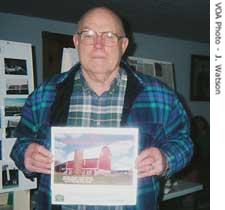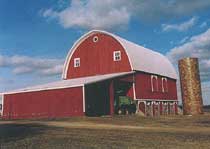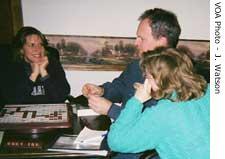VOA慢速英语 2007 0319b(在线收听)
VOICE ONE:
Welcome to THIS IS AMERICA in VOA Special English. I'm Steve Ember.
VOICE TWO:
And I'm Faith Lapidus. Every family has a story. Today we travel to a farm in the Midwest, the center of American agriculture, to meet the Fitzpatrick family.
(MUSIC)
VOICE ONE:
Thick snow falls on the quiet Michigan countryside as we make our way to visit Leo Fitzpatrick and his family.
The Fitzpatricks are among the minority of Americans who live a rural life. Instead of a big city, they live near small towns. And, unlike many families today, they all still live near each other.
As we drive along a country road, we can see many buggies in a line near a farmhouse. These belong to Leo's Amish neighbors. The people are attending religious services in a home. The Amish live as people did many years ago.
The horses that pull the buggies are nowhere to be seen -- probably warming up inside a barn.
VOICE TWO:
It seems hard to believe that any crop could survive this icy weather. The land is asleep. But not completely. Winter wheat grows in a field that belongs to the Fitzpatrick family.
Leo Fitzpatrick, the head of the family, farmed for most of his long life. Now he is leaving the work to his sons. The oldest son planted the wheat.
The Fitzpatrick family is well known in this corner of rural America. Some of them live on the family's one hundred fifteen hectares of land. Almost all have helped farm at some time or another, but most also hold other jobs. Some work in manufacturing. Another is an excavator; he has a digging and earth-moving business. Others work in a dentist's office, a post office and a courthouse.
VOICE ONE:
Leo Fitzpatrick's grandfather claimed land here more than one hundred years ago. In two thousand five, Leo was honored as the owner of the Michigan Centennial Farm of the Year. The honor goes to land that has been farmed by the same family for at least a century.
That might not sound like very long compared to other countries. But keep in mind that the United States is not yet two-and-a-half centuries old.
VOICE TWO:
 |
| Leo Fitzpatrick holds a picture of his prize-winning barn |
Leo explains that his grandfather, Dennis Fitzpatrick, built the barn more than ninety years ago. The family made repairs over the years. By the nineteen nineties, though, it became clear that the wooden structure would need a lot of work or it would have to be torn down.
Leo decided that he would restore the barn. He did much of the work himself, over a period of nine years. He also worked in a factory some of that time.
He used wood from trees in the area to strengthen and support the roof and the walls. To reach the roof he stood on bales of hay.
VOICE ONE:
Today the barn is a big star. In the last few years it has been named Michigan Barn of the Year and honored with the Barn Alive! Farm Heritage Award. The award is given by the National Trust for Historic Preservation and Successful Farming magazine.
 |
| Fitzpatrick's barn |
The barn is big enough to hold several hundred people. In warmer weather, the family uses it for social events like dances and special celebrations.
(MUSIC)
VOICE TWO:
Another building on the Fitzpatrick property is a workshop. It contains what seems like every tool ever manufactured. The tools line the walls.
The workshop feels warm and welcoming. A corn burner heats the building. Kernels of corn make a very hot fire, Leo says.
Now we are on the move again, following Leo and his footsteps through the snow. His house is not far. It just feels that way in the wind.
(SOUND)
VOICE ONE:
Inside the house, family members are seated around a table. On this snowy day, the extended family has gathered for a meal. Everyone brought food -- lots of food. Corn pudding is being heated up in the oven. It smells wonderful.
 |
| Judy Fitzpatrick Weber (left) playing Scrabble next to Paul Webber and Mary Fitzpatrick (Leo's daughter-in-law) |
Others in the family have been talking about family happenings and local news. The youngest family members are playing computer games on a huge television.
VOICE TWO:
Leo Fitzpatrick's wife, Mary, died in nineteen ninety-six. But he never has to worry about being alone.
(SOUND)
"My name is Linda. I'm the second child to Leo."
"I am Leo Fitzpatrick's third daughter, third in line. And my name is Judy Weber."
"I am Leo's friend, Judy Grant."
"Leo Fitzpatrick. I'm the daddy of the seven children assembled here."
"I'm Leah Fitzpatrick, and I'm Vernon Fitzpatrick's wife."
"I'm Vernon Fitzpatrick, and I'm Leah Fitzpatrick's husband."
"I'm Dan Fitzpatrick, I'm the oldest son of three."
"I'm Terry Fitzpatrick, I'm the second son of three."
"I'm Debbie Fitzpatrick. I'm the oldest daughter."
"I'm Rhonda Reppert, I'm number six in the family, youngest daughter."
"I'm Sarah Fitzpatrick. I'm Leo's granddaughter."
VOICE ONE:
Where is Mark, the youngest of Leo's three sons? Mark is somewhere else in the house.
Some of the family moved out the area for a while, but in time they returned. Leo's daughter Rhonda married a man named John Reppert. For years they lived near the biggest city in Michigan, Detroit.
VOICE TWO:
Rhonda Reppert says it was good to come back. The Repperts now live in a big house that was built for them. The house is made from logs of cedar wood.
John Reppert likes to hunt and fish. But if he wants to see wildlife, all he has to do is look out his window. Rhonda says deer often come right up to the house.
VOICE ONE:
Rhonda's brother Dan never left the area. After high school he spent more than twenty years as a welder and part-time farmer. Then he got his wish. He became a full-time farmer. He plants corn, wheat and oats on more than three hundred twenty hectares of land, including some family land.
His father says Dan has greatly improved the farm's production with up-to-date agricultural methods and equipment. Dan planted soybeans once, not too long ago. The crop did well. But it was a loss. It was destroyed by hungry deer.
The Fitzpatricks used to raise turkeys, but not anymore, not since wild turkeys invaded their farm.
VOICE TWO:
Debbie, the oldest of the Fitzpatrick children, lives with her father and her sister Linda. Debbie works at a post office. Linda works at a machinery company in the nearby town of Beaverton, Michigan.
The two sisters have never moved from their childhood home. But they remember how the family would take a two-week vacation every year when the children were growing up. Linda and Debbie now continue that tradition. They often go to Canada with other family members and have traveled as far as New Zealand.
(MUSIC)
VOICE ONE:
These days only about two percent of Americans farm for a living. Part-time farming and community farming are gaining popularity. But traditional family farms have largely been replaced by big, highly productive factory farms.
Fifty years ago, fourteen hours of labor on one hectare of land produced about one hundred bushels of corn, or maize. Now it can be done with less than half a hectare. These numbers come from the United States Department of Agriculture.
But Leo Fitzpatrick points out that farmers still work very hard. It is not unusual for a farmer to work day and night at planting and harvest times.
LEO FITZPATRICK: "With all the gadgets and things that's great for industry and everything, we're still people who live off the land. We're part of the land. You can eat an old cow, but you can't eat an old computer."
VOICE TWO:
Leo and his friend Judy Grant belong to several historical societies. Together they research family history, and Leo has written a book about his ancestors.
His grandparents on his mother's side were named Abraham Lincoln Brubaker and Emma Cecilia Shondell. They arrived in Michigan with almost enough children to start a school. The family came from the neighboring state of Ohio. Fourteen of their sixteen children were born there.
VOICE ONE:
Leo Fitzpatrick makes it clear that he wants to help save the memories of America's rural past. He wants people to know the story of the land and its people.
(MUSIC)
VOICE TWO:
Our program was written by Jerilyn Watson and produced by Caty Weaver. You can see pictures of the Fitzpatricks and their farm at voaspecialenglish.com. I'm Faith Lapidus.
VOICE ONE:
And I'm Steve Ember. From time to time we plan to introduce you to other American families, so keep listening. We hope you can join us again next week for THIS IS AMERICA in VOA Special English.